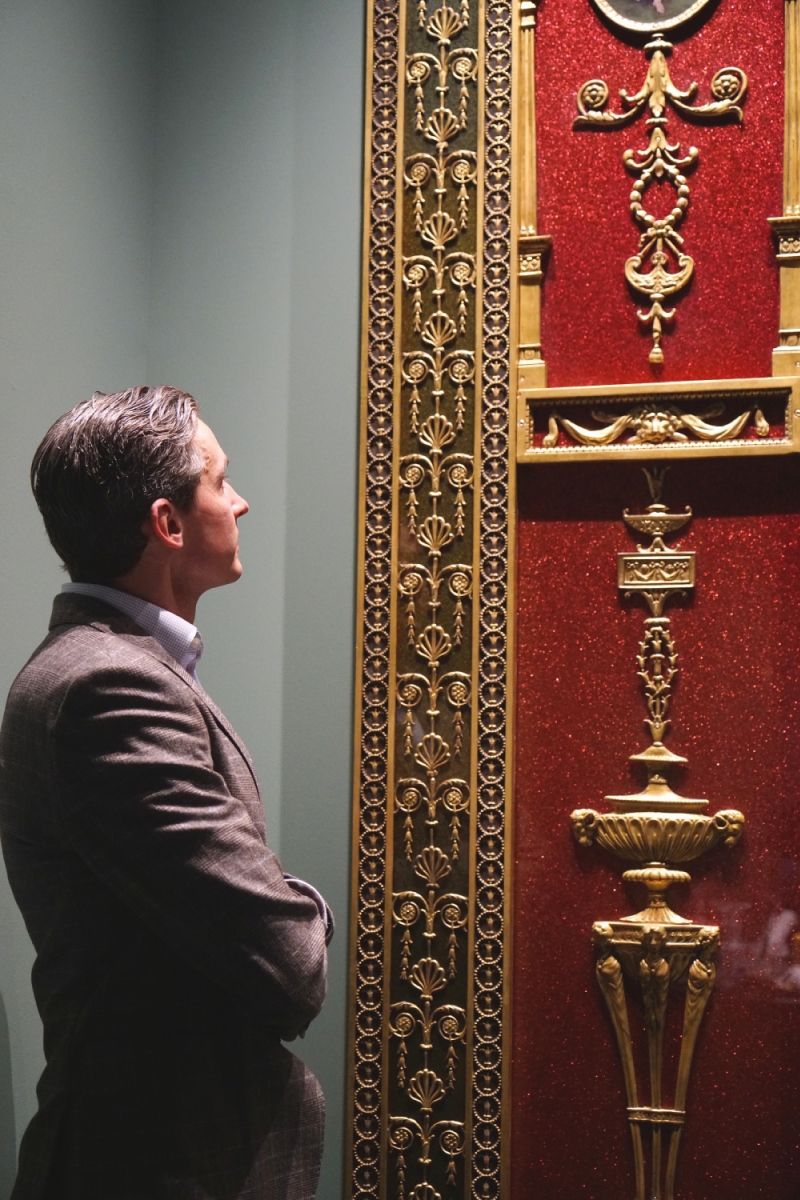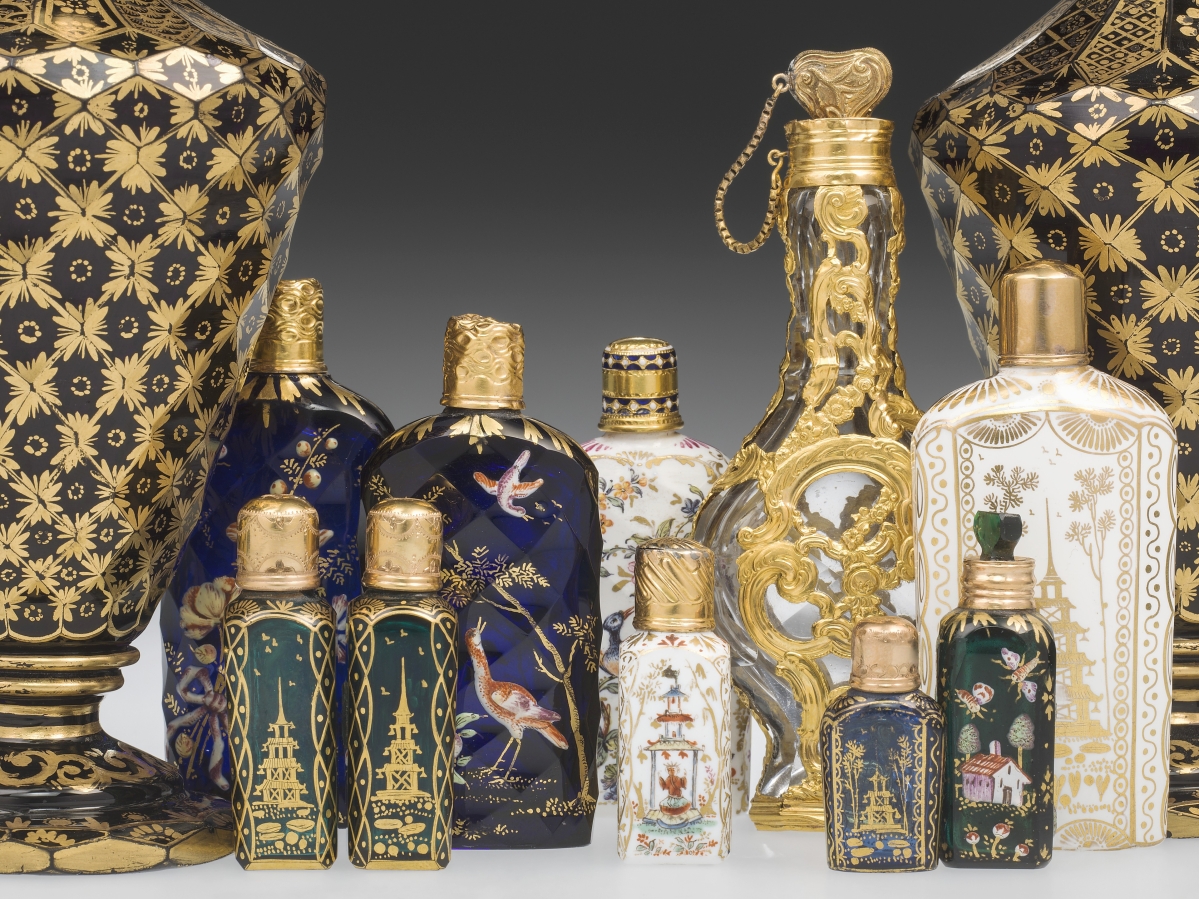
Scent flasks, England, 1760 to about 1790. The Corning Museum of Glass. Photo The Corning Museum of Glass, Corning.
By Karla Klein Albertson
CORNING, N.Y. – When historians list the precious materials valued in the past, we find the usual candidates – gold and silver, perhaps exotic silks and embroidery. But from ancient times until little more than a century ago, fine glass – often in combination with those other treasures – was among the most desirable and expensive of luxury goods. Elegant social gatherings were distinguished by polished surfaces, the reflection of expensive garments in windows and mirrors, and the festive clink of transparent drinking glasses.
The Corning Museum of Glass focuses its expert attention on a historic high point of the medium in the new exhibition “In Sparkling Company: Glass and the Costs of Social Life in Britain During the 1700s.” The show runs through January 2, 2022 and is accompanied by a comprehensive companion volume, which proves much that glitters is glass, not gold. The project organizer is Christopher L. Maxwell, the museum’s curator of early modern glass, who came to Corning in 2016 from across the pond, where he had completed many important projects, including a stint as assistant curator in the ceramics and glass section at the Victoria & Albert.
Glass-making had undergone centuries of technical development and innovation by the time it reached the elaborate forms of the Eighteenth Century. Ancient Egyptians were able to mold colored glass inserts that could be used in place of semiprecious gems in jewelry and furniture. By the end of the First Century BCE in the Graeco-Roman period, artisans had mastered most of the important techniques and could produce free-blown, mold-blown and molded shapes that were decorated by methods such as cutting or gilding. The drinking glasses, pitchers and perfume bottles familiar today all made an appearance, although they were rare possessions.
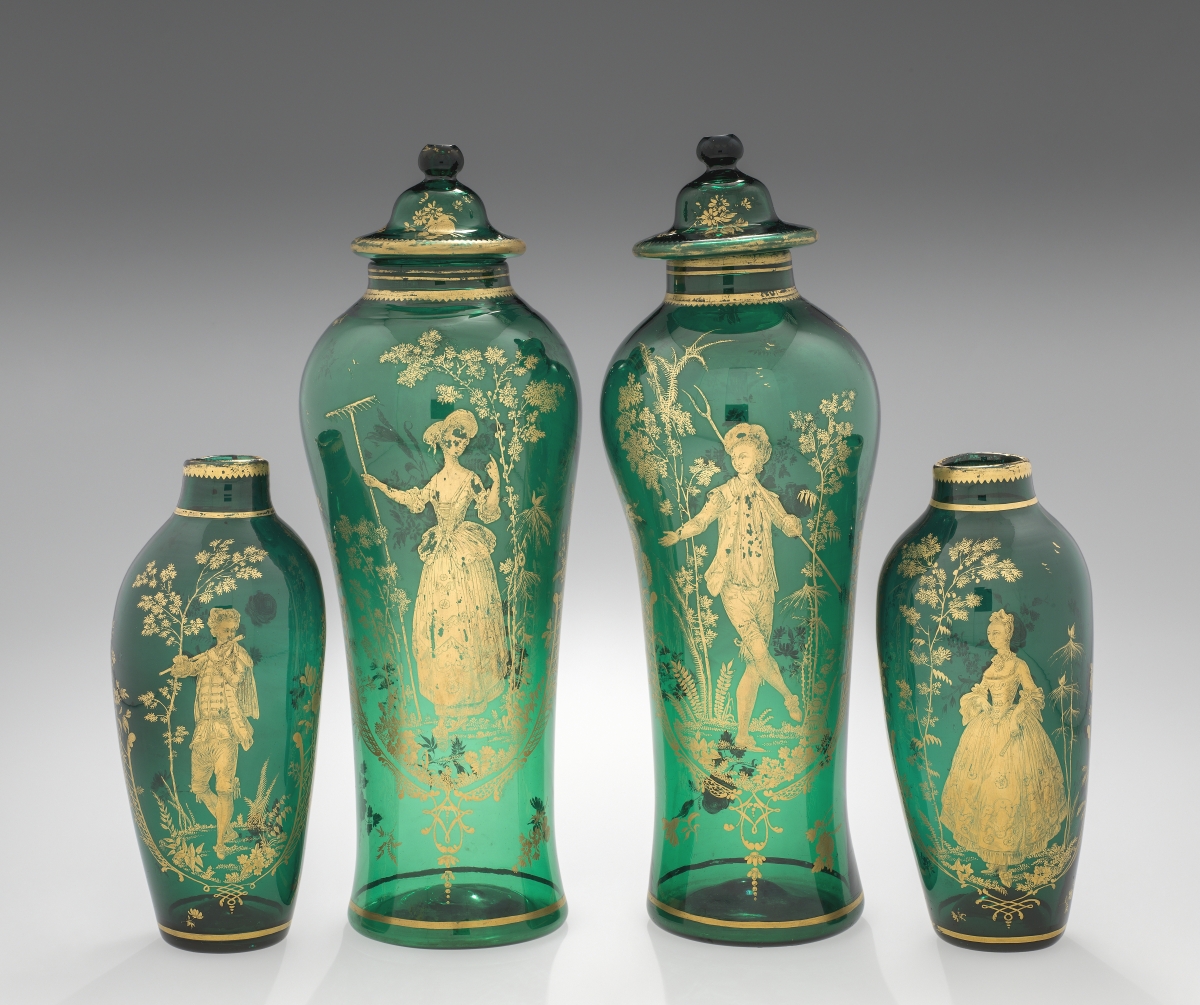
Pair of covered and standard green vases probably from the workshop of James Giles, London, about 1750-1775. Gilded copper-green lead glass. The Corning Museum of Glass. Photo The Corning Museum of Glass, Corning.
As the 1700s began, the appearance and desirability of the material had been enhanced by two breakthrough production processes. The introduction of a special glass formula with lead oxide produced a heavier and clearer crystal that was a great success for English glass houses. Likewise, an advanced method of producing large sheets of flat plate glass for mirrors and other surfaces offered new decorative possibilities. So many things people now take for granted, such as shops with glass storefronts, display cases and mirrors; homes with picture windows and sliding glass doors; cars with full visibility; or display screens on countless electronic devices came about through advancements in glass technology that began to march forward in this period.
In an interview with Antiques and The Arts Weekly, Maxwell explained how he wanted an exhibition that moved beyond mere display to answering more important questions about the role of glass in the chosen time period: “In museums, glass is mostly deployed in discussions of dining and drinking and in recreations of historic dining table settings or dessert services. I thought it highly unlikely that glass was just incidental to British culture in the Eighteenth Century. In trying to understand how glass fitted in, I naturally turned to Eighteenth Century texts to see how glass was talked about. I didn’t realize that the term polished and polite were used quite often, and glass was often used as a metaphor for politeness as in a refined, modern individual.”
Indeed, for the Latin verb polire – to polish or make smooth, the past tense meaning the polish job is done – politus – looks quite like polite. And Cicero would have used it to mean refined or accomplished as well as smoothed. Remove the rough edges of a chap from the country, and there emerges a polished gentleman. He could then become a polite presence in the drawing room and even the “glass of fashion,” reflecting the latest style.
Dr Maxwell continued, “Of course, lead glass was incredibly modern, and Britain in the Eighteenth Century was obsessed with modernity in the context of the Enlightenment. Commerce drove the nation’s prosperity, but taste was a key element of Britain’s modernity. So the objects that people owned were demonstrative of taste, and in my mind I began to view glass as a metaphor for politeness. They were deliberately chosen objects that conveyed modernity and taste in elite circles.”
The curator expands on the point in his chapter on “People in Glass Houses: The Polished and the Polite in Georgian Britain.” Referring to all sorts of reflective furnishings from mirrors to silver to polished wood, he states: “Smooth, gleaming surfaces, whether they transmitted, reflected or refracted light, became synonymous with the artificial simplicity, complaisance and cleanliness that constituted the principal ideals of polite culture and nurtured the cult of the polished.”
The accompanying volume, In Sparkling Company: Reflections on Glass in the 18th-Century British World, makes an immense contribution to understanding the multiple influences of glass during the 1700s, because it tackles the subject from so many different angles. “The book is a companion to the exhibition, but it’s not a traditional exhibition catalog,” explained the curator. “I wanted to cover the topic beyond drinking and dining, and I was very fortunate to have these seven other contributors. What they came back with, I think, was fascinating and showed how ready the field of glass is for study.”
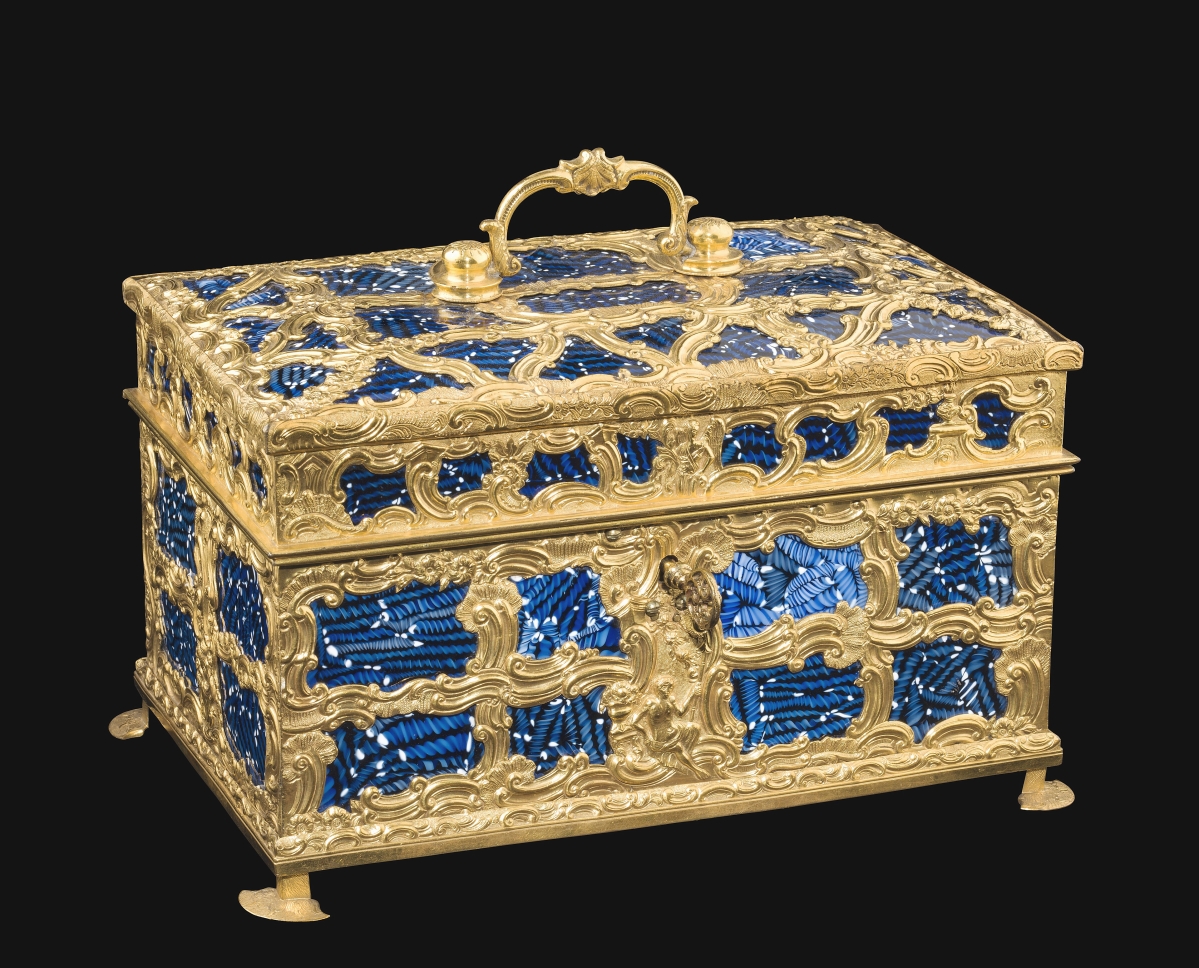
Casket with glass panels possibly by James Cox, probably England, about 1760-70. Fused, gilt and molded non-lead glass; metal. The Corning Museum of Glass, gift of Lucy Smith Battson. Photo The Corning Museum of Glass, Corning.
Furthest from the drinking glass norm, “The British Scientific Glass Enlightenment during the Long 18th Century” by Dr Marvin Bolt, Corning’s curator of science and technology, explores the crucial role of the material in the development of scientific instruments. An ornate telescoping spyglass with a clock on one end, circa 1750, looks like a trendy gadget, and thus Bolt explains, “Pocket devices were fashionable accessories for a self-respecting scientifically inclined gentleman or educated person throughout the 18th century….” And could be the opening gambit for a conversation with a lady.
Looking into “The Glass of Fashion,” Kimberly Chrisman-Campbell covers the essential presence of glass on the dressing table, both to hold perfume and cosmetics, and – above all – to provide a mirror image you could attempt to improve. She also explores and illustrates the use of glass beading and glass-paste gems to ornament elaborate costumes and accessories worn for aristocratic social occasions.
Remember those tiny glass beads purchased for craft projects? Think of the thousands of needlework hours required to attach a crust of gold and silver ones to an elegant formal coat. Readers of “who-stole-the-necklace” mysteries also know about larger glass imitation jewels which could be substituted for the real thing. On display in the gallery is a pair of multicolored earrings with “gems” of cut glass in a silver frame, made around 1760.
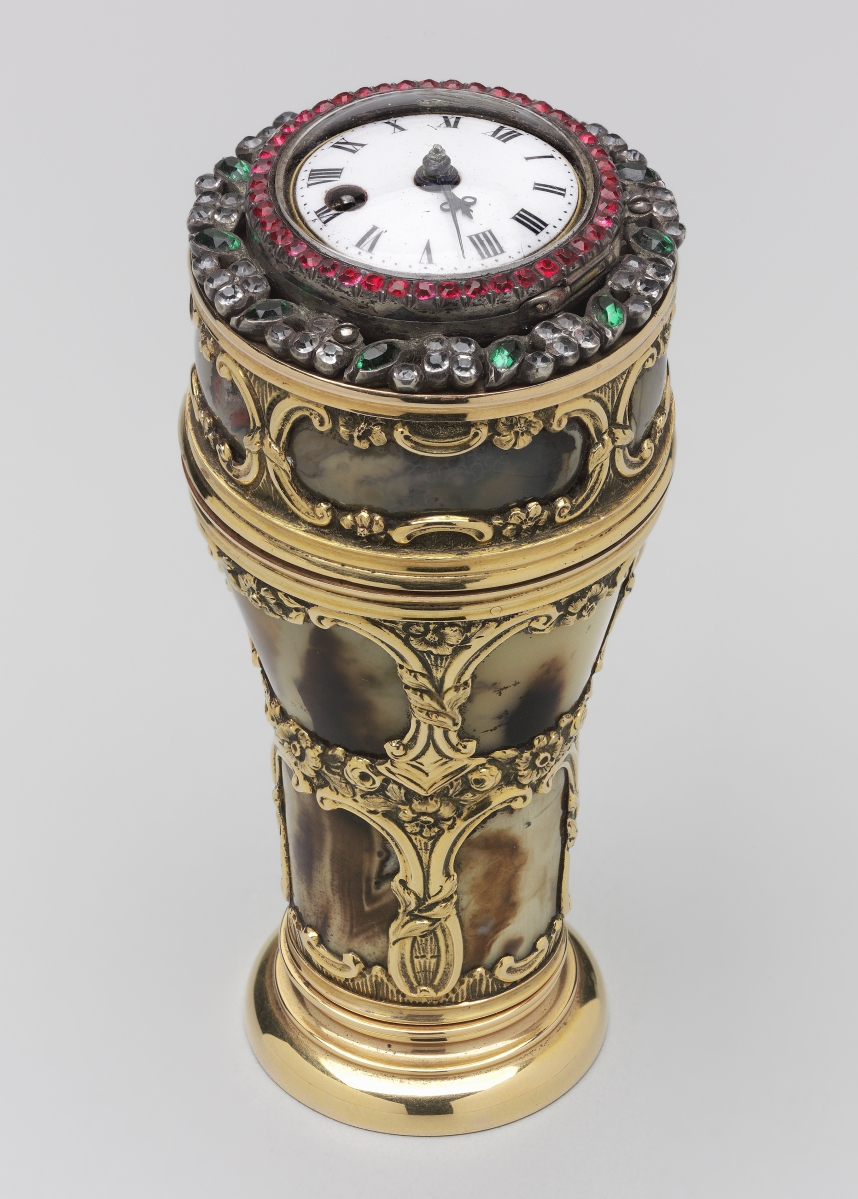
Telescoping spyglass with timepiece, England, about 1750. Gold, agate, diamonds, emeralds, rubies, glass lens. Museum of Fine Arts, Boston. Gift of the heirs of Bettina Looram de Rothschild. Photo ©2020 Museum of Fine Arts, Boston.
Another, more tragic, aspect of the material’s history is covered in “Slavery and Glass: Tropes of ‘Race’ and Reflection” by Kerry Sinanan, where she has written: “The history of glass is intertwined with that of slavery. This chapter seeks to tell a story about this history by selecting specific objects in which glass and the representation of glass occur alongside slavery.” Such objects include the bright colored Venetian glass “trade beads” in the exhibition, which were once used to barter for slaves.
Slightly unusual – but with a definite connection to British influence – the final chapter is “‘A Gloss Equal to Glass’: The Material Brilliance of Early American Furniture” by Jennifer Y. Chuong. The discussion focuses on furniture makers’ efforts to polish woods so highly they reflected the surrounding room. Examples illustrate how cabinetmakers mixed gleaming inlay with clear and silvered glass to achieve a play of reflective surfaces.
In conclusion, Dr Maxwell said: “There are many facets to this exhibition, and each display is on a completely different topic from chinoiserie to the American War for Independence to the Trans-Atlantic slave trade. I don’t think people will come inside expecting to see costumes, for example. I think they will be surprised how closely and in how many ways these objects relate to Britain’s global presence and its colonization, and how relevant that is in western New York, which was part of the British Empire at that time.”
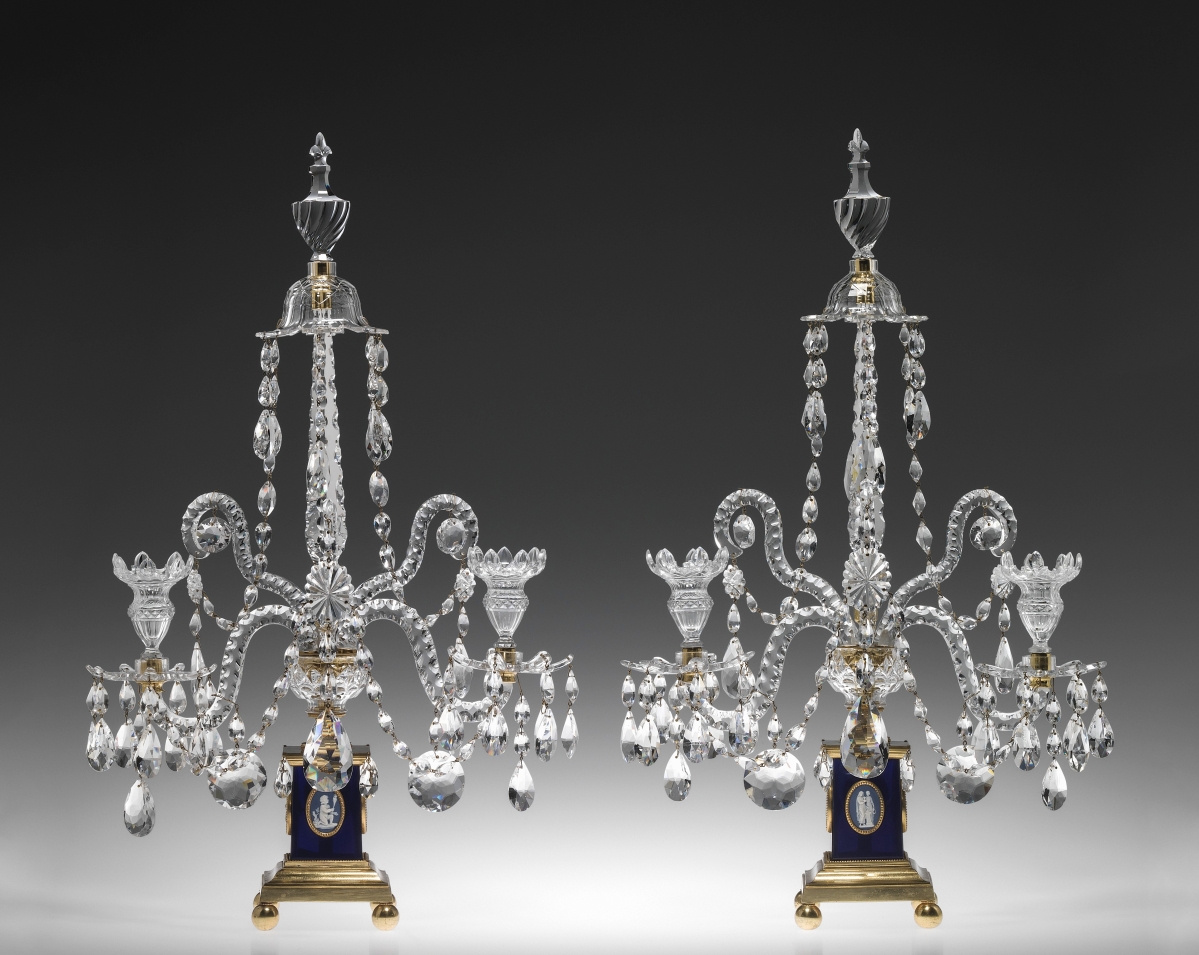
Pair of girandoles probably by Josiah Wedgwood & Sons Ltd. (founded 1759), probably England, Etruria, Staffordshire, about 1785. Tooled and cut lead glass, ceramic (jasperware), gilded metal. The Corning Museum of Glass. Photo The Corning Museum of Glass, Corning.
“Visitors will see the sheer diversity of types of glass. Each one will spark discussion, and I am going to call for papers for a seminar in the fall, which I hope will attract more diverse perspectives for this topic and keep the conversation going. Above all, the goal of the exhibition is to use the element of glass to show what it meant to be ‘modern’ in the 1700s – and what it cost. My hope is that this will be revealed by the objects and that people will leave with a sense of that.”
The Corning Museum of Glass with its galleries, glass-making school, and research library, is located in Corning, N.Y., just below the scenic Finger Lakes. To order In Sparkling Company: Reflections on Glass in the 18th-Century British World and for more information about exhibition events, call 607-937-5371 or go to www.cmog.org.

